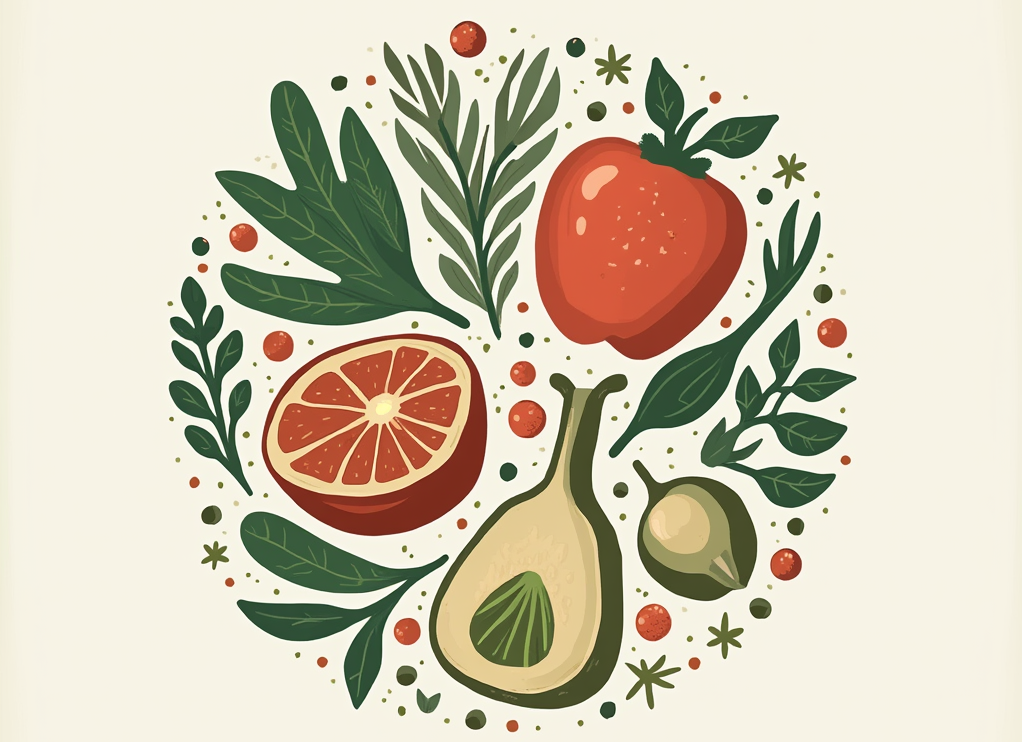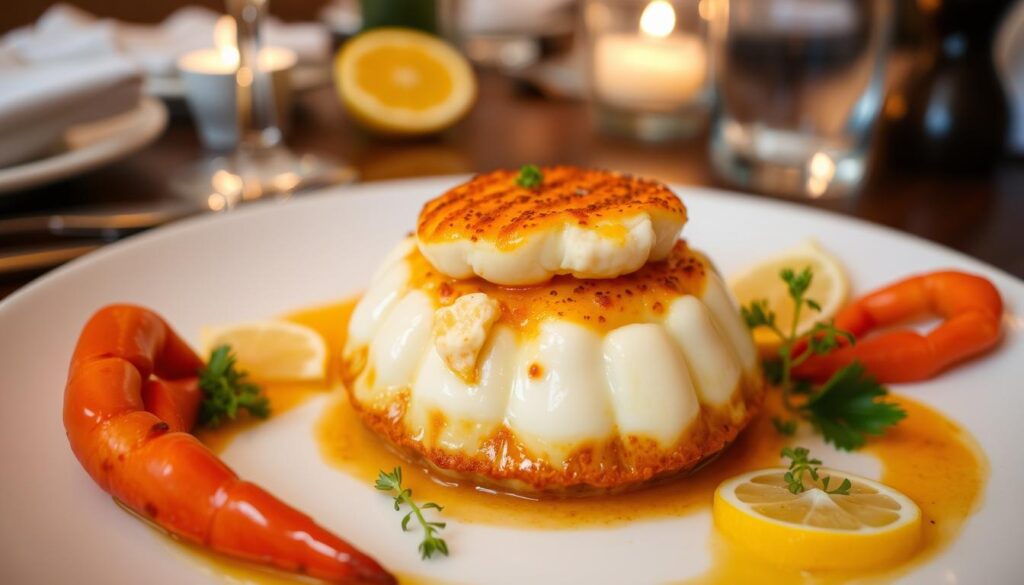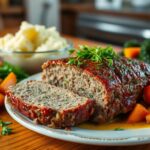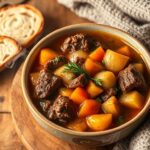Indulge in a decadent crab brûlée recipe that delivers a rich, creamy flavor in every bite.
Table of Contents
Indulge in the richness of crab meat with the creaminess of brûlée, a perfect combination for seafood recipes and decadent desserts. The crab brulee recipe is ideal for special occasions or for anyone looking to indulge in a rich and creamy dessert, making it a great addition to any seafood recipes collection.
With its unique blend of flavors and textures, this crab brulee recipe is sure to impress, offering a delightful twist on traditional decadent desserts. Whether you’re a fan of seafood recipes or just looking to try something new, this crab brulee recipe is a must-try, providing a truly decadent delight.
This delightful crab brulee recipe combines the best of both worlds, bringing together the freshness of crab meat with the richness of creamy brûlée, resulting in a truly unique and decadent dessert that’s perfect for any occasion, and a great example of creative seafood recipes.
Understanding the Origins of Crab Brûlée
Crab brûlée is a dish that has gained popularity in recent years, and its origins can be traced back to French cuisine. The concept of brûlée recipes has been around for centuries, with the first recorded recipe dating back to the 17th century. Over time, various ingredients have been incorporated into brûlée recipes, including crab meat, to create unique and delicious flavor combinations.
The evolution of seafood brûlées has been significant, with many chefs experimenting with different types of seafood, such as lobster and shrimp. However, crab meat recipes have become particularly popular due to the rich flavor and texture of crab. French cuisine has played a significant role in the development of crab brûlée, with many French chefs contributing to its evolution.
French Culinary Influence
French cuisine is renowned for its emphasis on rich flavors and intricate preparations. The incorporation of crab meat into brûlée recipes is a testament to the French culinary tradition of combining high-quality ingredients to create exquisite dishes. The use of crab meat in brûlée recipes has become a staple in many French restaurants, with each establishment offering its unique twist on the classic dish.
Evolution of Seafood Brûlées
The evolution of seafood brûlées has been shaped by various factors, including the availability of fresh seafood and the creativity of chefs. As a result, a wide range of seafood brûlée recipes has emerged, each with its unique flavor profile and texture. From traditional crab brûlée to more innovative recipes featuring other types of seafood, the options are endless.
Modern Interpretations
Modern interpretations of crab brûlée have led to the creation of new and exciting flavor combinations. Chefs are now experimenting with different types of crab, such as king crab and Dungeness crab, to create unique and delicious brûlée recipes. The incorporation of other ingredients, such as truffles and caviar, has also become popular, adding an extra layer of luxury to the dish.
- Crab and avocado brûlée
- Crab and mushroom brûlée
- Crab and spinach brûlée
These variations showcase the versatility of crab brûlée and the endless possibilities for creativity and innovation in the culinary world.
| Ingredient | Quantity |
|---|---|
| Crab meat | 1 cup |
| Cream | 1 cup |
| Sugar | 1/2 cup |
Essential Ingredients for the Perfect Crab Brûlée
To create a decadent crab brûlée, it’s crucial to select the freshest ingredients, including fresh crab meat, cream, sugar, and eggs. When it comes to seafood recipes, the quality of the ingredients can make all the difference. For crab meat recipes, look for jumbo lump crab meat that is free of shells and cartilage.
A key component of creamy desserts like crab brûlée is the cream. Heavy cream or a combination of heavy cream and whole milk will provide the richness and texture needed for the dish. Sugar, of course, is essential for caramelizing the top of the brûlée, while eggs will help to create a smooth and creamy custard.
When preparing the ingredients, be sure to handle the crab meat gently to avoid breaking up the lumps. Also, make sure to whisk the eggs and sugar together until well combined, then slowly add the cream to create a smooth mixture. By using the freshest ingredients and following these tips, you’ll be well on your way to creating a delicious crab brûlée that’s sure to impress.
Some other essential ingredients to have on hand when making crab brûlée include:
- Freshly ground nutmeg
- Salt
- Unsalted butter, melted
- Fresh parsley or chives for garnish
By combining these ingredients with the freshest crab meat and cream, you’ll be able to create a rich and creamy dessert that’s perfect for special occasions or everyday meals. With a little practice and patience, you’ll be a master of seafood recipes like crab brûlée in no time.
Required Kitchen Equipment and Tools
To prepare the crab brûlée recipe, it’s essential to have the right kitchen equipment and tools. This includes cooking vessels such as saucepans, mixing bowls, and ramekins. The quality of these vessels can affect the final result, so it’s crucial to choose them wisely.
In addition to cooking vessels, specialty equipment like a kitchen torch and a hand mixer can be useful. A kitchen torch is necessary for caramelizing the sugar on top of the brûlée, while a hand mixer can help with mixing the ingredients.
Essential Cooking Vessels
- Saucepan: for heating the cream and sugar mixture
- Mixing bowl: for whisking the eggs and mixing the ingredients
- Ramekins: for baking the brûlée
Specialty Equipment Needed
Some specialty equipment can make the preparation process easier and more efficient. These include:
- Kitchen torch: for caramelizing the sugar
- Hand mixer: for mixing the ingredients
Alternative Tool Options
If you don’t have some of the specialty equipment, there are alternative tool options available. For example, you can use a broiler instead of a kitchen torch to caramelize the sugar.
| Equipment | Alternative Option |
|---|---|
| Kitchen torch | Broiler |
| Hand mixer | Whisk |
Selecting and Preparing Fresh Crab Meat
When it comes to creating delicious seafood recipes, especially those that feature crab meat recipes, the quality of the fresh crab meat is paramount. To ensure the best flavor and texture, it’s essential to select and prepare the crab meat properly. Here are some tips to help you make the most of your fresh crab meat.
To start, look for crab meat that is firm, flaky, and has a pleasant ocean-like aroma. Avoid any crab meat that has a strong, fishy smell or appears soft and soggy. You can find fresh crab meat at most seafood markets or well-stocked supermarkets. Some popular types of crab meat include jumbo lump, claw meat, and flaked crab meat.
- Choose crab meat that is sustainably sourced and harvested to ensure the long-term health of crab populations.
- Store fresh crab meat in the refrigerator at a temperature of 38°F (3°C) or below to prevent spoilage.
- Before using, gently rinse the crab meat under cold running water to remove any impurities.
By following these simple tips, you can enjoy delicious and fresh crab meat recipes that are sure to impress your family and friends. Whether you’re making a simple seafood recipe or a more complex dish, the quality of the fresh crab meat will shine through.
The Complete Crab Brûlée Recipe
To create a decadent crab brulee recipe, it’s essential to understand the importance of each component. The base mixture, custard, and caramelization technique all play a crucial role in producing a rich and creamy dessert. By mastering these elements, you’ll be able to craft a truly exceptional crab brulee that showcases the sweetness of the crab and the depth of the caramelized sugar.
The process begins with the preparation of the base mixture, which typically consists of cream, sugar, and eggs. This mixture is then combined with fresh crab meat, which adds a delicate flavor and texture to the dish. The custard is created by gently cooking the mixture over low heat, stirring constantly to prevent curdling. This step requires patience and attention to detail, as the custard must be cooked to a precise temperature to achieve the perfect consistency.
Base Mixture Preparation
The base mixture is the foundation of the crab brulee recipe, and it’s essential to get it right. The mixture should be smooth and creamy, with a subtle sweetness that complements the flavor of the crab. To achieve this, it’s crucial to use high-quality ingredients, including fresh cream and real sugar.
Custard Creation
Once the base mixture is prepared, it’s time to create the custard. This involves gently cooking the mixture over low heat, stirring constantly to prevent curdling. The custard should be cooked to a precise temperature, which will help to achieve the perfect consistency. This step requires patience and attention to detail, as the custard is a critical component of the crab brulee recipe.
By following these steps and mastering the caramelization technique, you’ll be able to create a truly exceptional crab brulee that showcases the sweetness of the crab and the depth of the caramelized sugar. This creamy dessert is sure to impress your guests and leave them wanting more, making it a perfect addition to any menu of creamy desserts.
Caramelization Technique
The final step in the crab brulee recipe is the caramelization technique, which involves sprinkling a layer of sugar over the top of the custard and caramelizing it with a blowtorch. This step adds a rich, caramelized flavor to the dish and creates a beautiful, golden-brown crust. By mastering the caramelization technique, you’ll be able to take your crab brulee to the next level and create a truly show-stopping dessert.
Mastering the Caramelization Process
To achieve a perfect caramelized crust, it’s essential to understand the caramelization technique. This process involves heating sugar slowly to a high temperature, creating a rich, deep flavor and a crunchy texture. Temperature control is crucial in this process, as it affects the sugar melting points and the final texture of the crust.
Here are some tips for mastering the caramelization process:
- Use a thermometer to monitor the temperature, ensuring it reaches the optimal range for caramelization.
- Heat the sugar slowly and evenly, stirring constantly to prevent burning.
- Don’t stir the mixture too much, as this can prevent the formation of a smooth, even crust.
By following these tips and practicing the caramelization technique, you’ll be able to create a perfect caramelized crust for your crab brûlée. Remember to control the temperature and monitor the sugar melting points to achieve the desired texture and flavor.
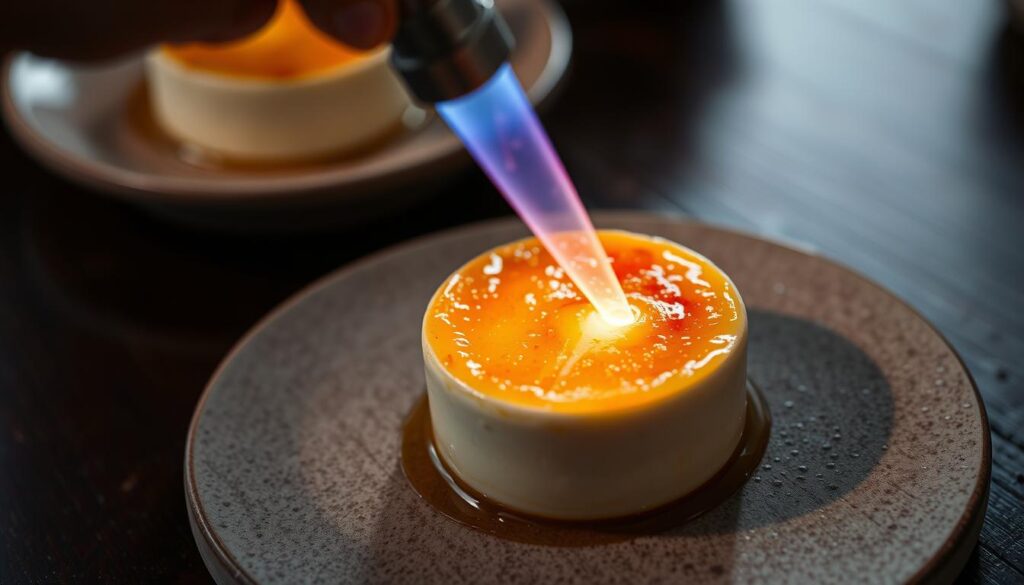
| Temperature | Sugar Melting Points | Caramelization Technique |
|---|---|---|
| 300°F – 350°F | 160°C – 180°C | Slow heating, stirring constantly |
Critical Temperature Control Tips
Temperature control is a crucial aspect of preparing the perfect crab brûlée. It requires attention to detail and a thorough understanding of the optimal cooking temperature, sugar melting points, and cooling requirements. To achieve the desired texture and flavor, it’s essential to maintain a consistent temperature throughout the cooking process.
The ideal cooking temperature for crab brûlée is between 325°F and 350°F. This range allows for the gentle cooking of the eggs and cream, while preventing the formation of unwanted lumps or curdling. Additionally, it’s vital to monitor the sugar melting points, as excessive heat can cause the sugar to caramelize too quickly, leading to an unpleasant texture.
Optimal Cooking Temperature
When it comes to cooking temperature, precision is key. A temperature that’s too high can result in a curdled or scrambled texture, while a temperature that’s too low can prevent the eggs from setting properly. To ensure optimal results, it’s recommended to use a thermometer to monitor the temperature accurately.
Sugar Melting Points
Sugar melting points play a significant role in the caramelization process. The ideal sugar melting point for crab brûlée is between 300°F and 320°F. At this temperature, the sugar will caramelize slowly, creating a rich, golden-brown crust. However, if the temperature exceeds 350°F, the sugar can burn or become too dark, affecting the overall flavor and texture of the dish.
Cooling Requirements
Cooling requirements are often overlooked, but they’re essential for preventing the growth of bacteria and ensuring food safety. After cooking, it’s crucial to cool the crab brûlée to room temperature within a specific timeframe. This can be achieved by placing the dish in an ice bath or by using a blast chiller. By controlling the cooling process, you can prevent the formation of unwanted crystals and maintain the desired texture.
By following these critical temperature control tips, you’ll be able to create a decadent and delicious crab brûlée that’s sure to impress your guests. Remember to always prioritize temperature control, as it’s the key to achieving the perfect texture and flavor.
| Temperature Range | Optimal Results |
|---|---|
| 325°F – 350°F | Gentle cooking, no lumps or curdling |
| 300°F – 320°F | Slow caramelization, golden-brown crust |
Common Troubleshooting Guide
When preparing the Crab Brûlée recipe, it’s essential to be aware of common mistakes that can occur during the process. Troubleshooting these issues can help you achieve the perfect dish. Some common mistakes include overcooking the custard, not caramelizing the sugar properly, or using low-quality ingredients.
To avoid these mistakes, it’s crucial to follow the recipe carefully and pay attention to the cooking times and temperatures. Here are some solutions to common problems:
- Overcooking the custard: Check the custard frequently while it’s cooking, and remove it from the heat as soon as it’s set.
- Not caramelizing the sugar properly: Use a kitchen torch to caramelize the sugar, and make sure to hold the flame at the right distance to achieve the perfect golden-brown color.
- Using low-quality ingredients: Choose fresh and high-quality ingredients, such as fresh crab meat and real cream, to ensure the best flavor and texture.
By being aware of these common mistakes and taking steps to prevent them, you can ensure that your Crab Brûlée turns out perfectly. Remember to always follow the recipe carefully and use high-quality ingredients to achieve the best results.
| Common Mistakes | Solutions |
|---|---|
| Overcooking the custard | Check the custard frequently while it’s cooking |
| Not caramelizing the sugar properly | Use a kitchen torch to caramelize the sugar |
| Using low-quality ingredients | Choose fresh and high-quality ingredients |
Creative Flavor Variations
When it comes to crab brûlée, the possibilities for creative flavor variations are endless. By incorporating unique flavor variations, herb infusions, and spice combinations, you can take this decadent dish to the next level. For instance, a hint of lemon zest or a sprinkle of paprika can add a delightful twist to the traditional recipe.
Some popular flavor variations include infusing the cream with herb infusions like thyme or rosemary, which complement the rich flavor of the crab. Alternatively, you can experiment with spice combinations like cayenne pepper or smoked paprika to add a smoky depth to the dish. These creative flavor variations can help you develop a signature crab brûlée recipe that showcases your culinary skills.
Here are some ideas for creative flavor variations:
- Lemon-garlic: Infuse the cream with lemon zest and garlic for a bright, citrusy flavor
- Smoked paprika: Add a smoky depth to the dish with a sprinkle of smoked paprika
- Thyme and rosemary: Infuse the cream with thyme and rosemary for a herbaceous, savory flavor
By experimenting with different flavor variations, herb infusions, and spice combinations, you can create a unique and delicious crab brûlée recipe that will impress your friends and family. So don’t be afraid to get creative and try new things – the possibilities are endless!
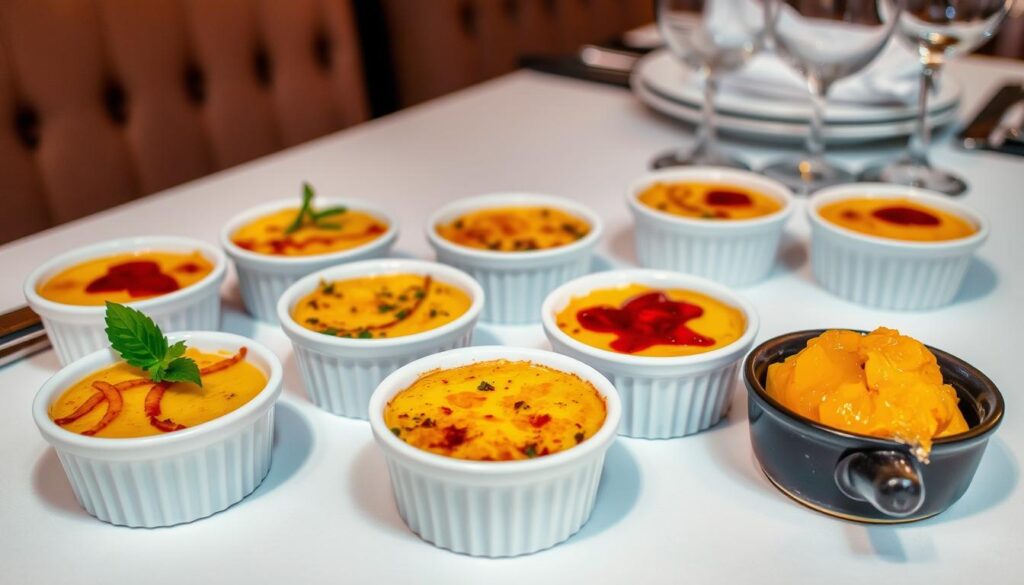
| Flavor Variation | Description |
|---|---|
| Lemon-garlic | Bright, citrusy flavor with a hint of garlic |
| Smoked paprika | Smoky depth with a subtle spicy kick |
| Thyme and rosemary | Herbaceous, savory flavor with a hint of earthy notes |
Perfect Wine Pairing Suggestions
When it comes to enjoying crab brûlée, wine pairing can elevate the dining experience. The right wine can complement the rich flavors of the dish, creating a perfect harmony of tastes. To achieve this, consider the following wine suggestions:
- Chardonnay: a buttery and oaky wine that pairs well with the creamy texture of crab brûlée
- Sauvignon Blanc: a crisp and refreshing wine that complements the delicate flavors of the crab
- Pinot Grigio: a light and citrusy wine that pairs nicely with the subtle sweetness of the brûlée
These perfect pairings can enhance the overall flavor profile of the dish, creating a truly decadent experience. By considering the characteristics of the wine and the dish, you can find the ideal wine pairing
Ultimately, the key to a successful wine pairing is to experiment and find the combination that works best for you. With a little practice and patience, you can become a master of wine suggestions and elevate your dining experiences to new heights.
| Wine | Characteristics | Pairing Suggestions |
|---|---|---|
| Chardonnay | Buttery, oaky | Crab brûlée, creamy sauces |
| Sauvignon Blanc | Crisp, refreshing | Delicate fish, citrus-herb sauces |
| Pinot Grigio | Light, citrusy | Subtle flavors, sweet dishes |
Plating and Presentation Tips
When it comes to presenting your crab brûlée, the key is to create a visually appealing dish that will impress your guests. This is where plating and presentation come into play. A well-presented dish can elevate the overall dining experience, making it more enjoyable and memorable.
To start, consider the color and texture of your dish. A delicate balance of colors and textures can add depth and visual interest to your presentation. For example, you could garnish your crab brûlée with a sprinkle of paprika or a few fresh herbs, such as parsley or chives, to add a pop of color and freshness.
Garnish Ideas
- Fresh herbs, such as parsley or chives
- Edible flowers, such as violas or pansies
- Microgreens, such as pea shoots or radish greens
- Citrus zest, such as lemon or orange
In addition to garnishes, consider the temperature at which you serve your dish. Serving your crab brûlée at the right temperature can enhance the flavors and textures, making it more enjoyable to eat. For example, serving it chilled can help to balance the richness of the cream and the sweetness of the caramelized sugar.
Serving Temperatures
Serving temperatures can vary depending on personal preference, but here are some general guidelines:
| Temperature | Description |
|---|---|
| Chilled | Refrigerate for at least 2 hours before serving |
| Room temperature | Let it sit at room temperature for 30 minutes to 1 hour before serving |
By paying attention to the details of plating and presentation, including garnish ideas and serving temperatures, you can create a truly memorable dining experience for your guests. With a little creativity and attention to detail, you can take your crab brûlée to the next level and make it a dish to remember.
Conclusion
As we conclude our exploration of the delectable crab brûlée, we can’t help but savor the flavors and appreciate the art of mastering this captivating dish. From understanding its French culinary roots to experimenting with modern flavor variations, the journey has been both enlightening and delicious. The final thoughts we leave you with are a testament to the versatility and sheer delight of this seafood-inspired creation.
Whether you’re a seasoned home chef or a newcomer to the world of crab brûlée, we hope this comprehensive guide has equipped you with the necessary recommendations and techniques to elevate your culinary skills. Embrace the art of caramelization, explore the interplay of textures, and let your creativity shine as you craft your own version of this decadent delight.
As you embark on your crab brûlée journey, remember to savor every bite, experiment with bold flavors, and share the experience with loved ones. The path to culinary mastery is paved with delicious discoveries, and the crab brûlée is a shining example of the joys that await. Bon appétit!
